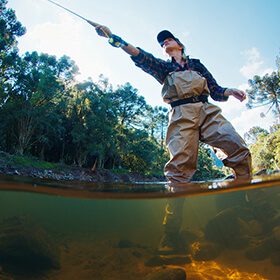Backcountry fishing in high mountain lakes is an experience that combines adventure in the remote wilderness and the excitement of exploring unpressured waters for trout. High altitude fishing trips are focused on some of the most breathtaking alpine settings imaginable. Check out these four reasons to try catching trout in high mountain lakes.
Experiencing the Pristine Beauty of Mountain Lakes
High mountain lakes, nestled among rocky peaks and surrounded by untouched forests, present an idyllic backdrop for fishing during the months from June through September. These lakes are typically formed by glacial activity and are fed by snowmelt, resulting in crystal-clear, cold waters. The clarity and purity of these lakes make them ideal habitats for several species of trout — including cutthroat, rainbow, golden, and brook trout.
The challenge of reaching these remote locations is part of the appeal. Many high mountain lakes in places like Colorado, Wyoming, Idaho, and Montana require long hikes, sometimes involving steep climbs and rugged terrain up to elevations around 7,000-9,000 feet. While it takes effort to reach these secluded spots, the trip up is usually rewarded with breathtaking views and amazing trout fishing opportunities. Backcountry Fishing

Learning to Prepare for Remote Fishing Adventures
Preparation is key to a safe and successful summer backcountry fishing trip, which includes having the right gear, clothing, and adequate food and water supplies. Guided backcountry trips are highly recommended for anyone who is new to high mountain lake fishing – the wisdom and experience of a knowledgeable guide will make your trip safer and easier.
Fly fishing gear is typically preferred when targeting trout in high mountain lakes. Trout can be very selective, only taking small flies that land naturally on the surface of the water. Bring a 3 to 5 weight fly rod, along with a fly box that is stocked with plenty of midge, caddisfly, mayfly and terrestrial imitations. Waders are good to have along, but they aren’t always necessary if you can cast from the shore. Research the area or ask your guide to help you make the best decisions on the type of gear to bring along.
Proper clothing is crucial, as weather conditions in the mountains can be unpredictable. Layered clothing, a waterproof rain jacket, and sturdy hiking boots are essential. Additionally, a well-stocked first aid kit, GPS device, hiking snacks (best backpacking food for high altitude fishing trips includes trail mix, dried fruit, and beef jerky), water, and backpacking water filter. Backcountry Fishing
The Reward of the Catch
High mountain lakes are home to a variety of fish species, with rainbow trout, brook trout, and cutthroat trout being the most common. Check with the state fish and wildlife agency for information on fish stocking history and alpine lake access. The challenge of hiking up to higher altitudes and learning new fly fishing techniques for alpine lakes adds to the reward of every catch.
Conservation and Respect
When going on a high mountain trip, it’s important to practice responsible fishing and respect for the environment. This means adhering to catch-and-release practices whenever possible, checking backcountry fishing permit requirements, following local fishing regulations, and leaving no trace of your presence. Respecting wildlife and preserving the natural ecosystems will help ensure that future generations can enjoy the same experiences.
